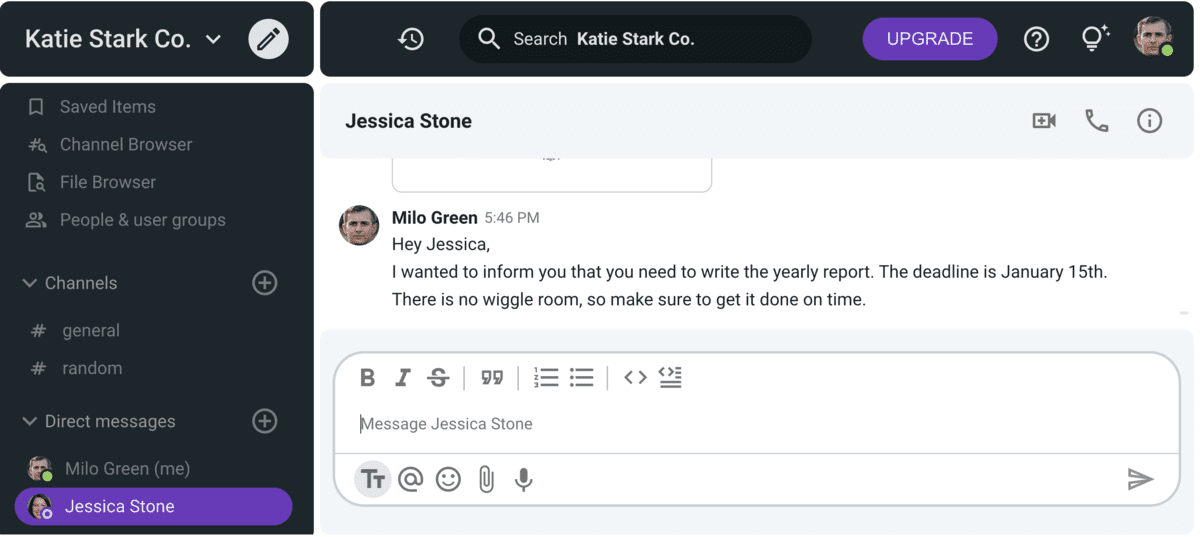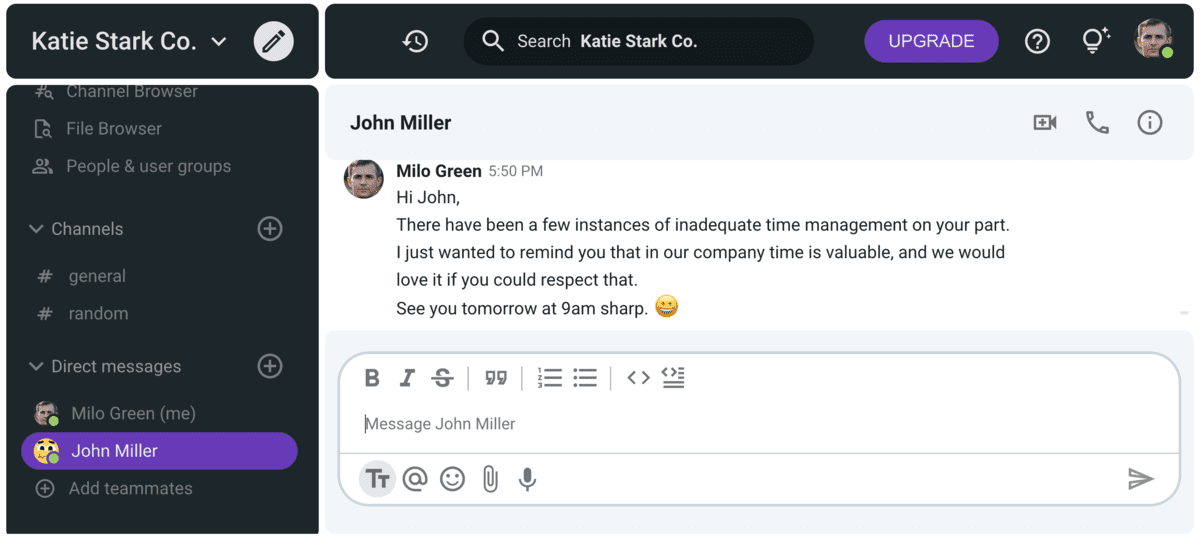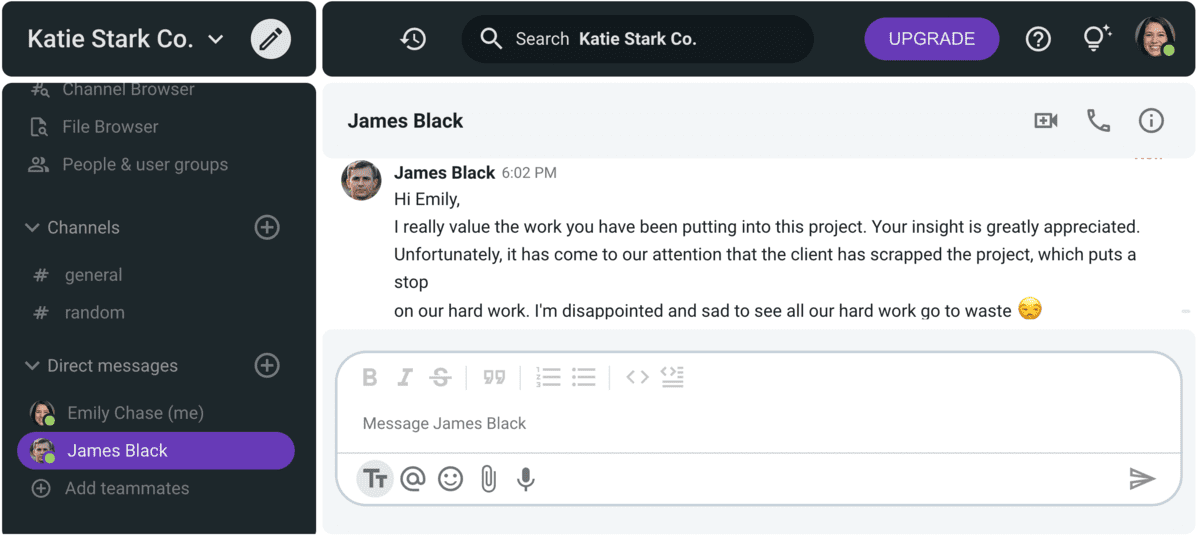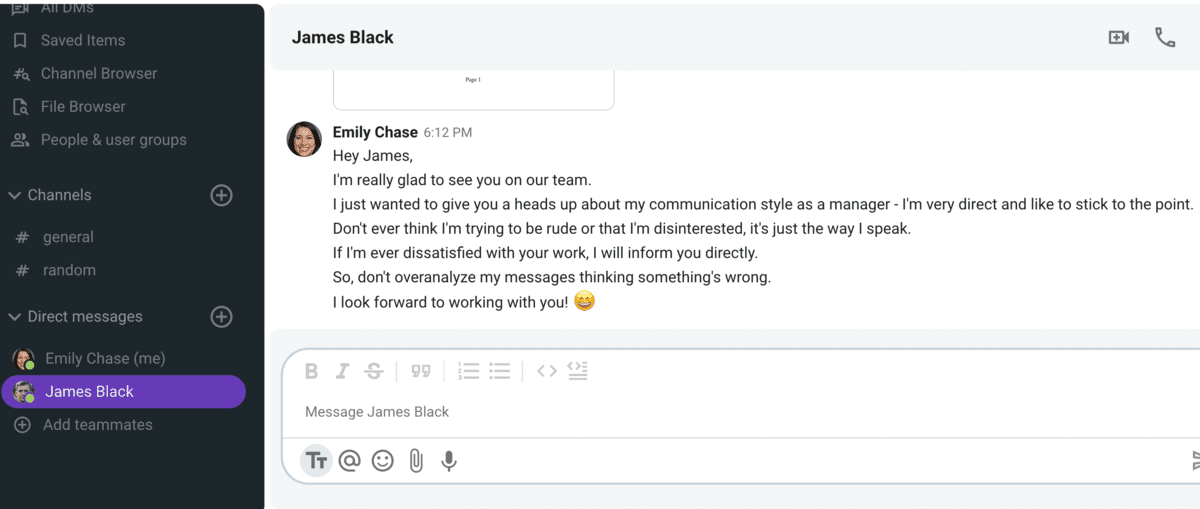You are walking to work on a Monday morning and you know you’re a bit late, but it’s no big deal, right?
After all, your manager has never said you mustn’t be late.
“I would appreciate it if you could get to work on time” doesn’t hold that much weight.
You walk into your office, and on your desk is a letter of termination. Reason for termination: “repeated difficulty in getting to work on time.”
You are then left wondering why no one has directly communicated with you that it’s such a big deal to be late to work from time to time.
If your manager had stated this clearly, you wouldn’t be so relaxed about being late.
This is a prime example of the importance of direct communication in the workplace.
Setting clear boundaries and establishing strict rules can only be achieved with a direct style of communication.
In this blog post, we will learn more about:
- Direct and indirect communication,
- Types of communication styles,
- Advantages of direct communication, and
- Tips to make direct communication more pleasant.
Let’s start.

Table of Contents
What is direct communication?
Direct communication is a style of communication that conveys information in a clear and straightforward manner. When you communicate directly, you ensure that your interlocutor receives the intended message the way you meant for it to be understood.
Direct communication leaves no room for error or confusion, and it also harbors no hidden meanings or pretenses.
Basically, you say what you mean and mean what you say.
Furthermore, traits of direct communication are active listening and constructive feedback.
In order to be able to communicate directly, you need to actively listen to the person you’re talking to.
Comprehending and retaining information is a precursor to responding in a direct manner.
Also, for feedback to be constructive — it has to be direct.
For example, when you praise your coworker, it’s always better to be direct.
A meaningful compliment where you highlight precisely why you like what your coworker does is better than a general phrase such as “Good job”.
In the workplace, direct communication is especially important to avoid mistakes.
By communicating directly, you make sure to avoid conflicts and misunderstandings.
Also, if you are in a managing position, direct communication is a way to exert authority and ensure that your employees know what you need from them.
In this example, you can see how the manager directly communicates their expectations to an employee:

What is indirect communication?
On the opposite side of the communication style spectrum lies indirect communication.
Indirect communication is a manner of communication where the speaker doesn’t directly state their opinions, ideas, and thoughts.
The speaker with an indirect style of communication doesn’t just rely on their words to convey the message but also uses nonverbal cues, such as:
- Facial expressions,
- Tone and pitch of voice,
- Body language, and
- Eye contact.
Also, the ideas are not clearly stated. Rather, the speaker hints at the meaning or uses nuanced language to express themselves in a more subtle way.
The ideas are camouflaged and the true intentions are hidden by vague language and carefully chosen words.
People who have this style of communication often use it to avoid conflict or embarrassment.
Indirect communication can result in difficulties in understanding the intended message.
The person you’re communicating with may not understand the message if it’s only hinted at, and not directly stated.
In the workplace, indirect communication can lead to misunderstandings and mistakes.
The example in the introduction is a prime example of miscommunication.
The manager didn’t want to be too harsh and assumed the employee would understand the hidden message of “don’t be late for work”.
Instead, the employee was under the impression that that is not a strict rule to be followed, but rather a suggestion.
If the manager was direct in communicating this rule, the employee would have followed it.
In the example below, you can see how an indirect style of communication may be incorporated into the workplace:

Direct vs indirect communication
Now, let’s look at some specific differences between direct and indirect communication.
Difference #1: Word choice
When it comes to direct communication, it usually involves specific words — and not a lot of them.
Usually, people who communicate directly will express themselves in fewer words.
Also, they choose words with their literal meaning in mind, not their metaphorical or symbolic meaning.
Indirect communication usually involves words carefully chosen for the purpose of not offending or angering anyone.
Polite speech is one of the key components of indirect communication, and this is often accomplished at the expense of meaning and substance.
People who have this style of communication often use figures of speech, such as metaphors, to get their point across without stating it directly.
Here are a few examples of the differences between direct and indirect communication:
| Direct communication | Indirect communication |
|---|---|
| That’s wrong. | I’m not sure that’s right. |
| You need to help me. | It would be great if you could help me. |
| You can’t take the weekend off. | I’m not sure we can handle the workload without you this weekend. How about you take the next one off? |
| What’s your job? | What industry do you work in? |
| Come to my office. | Stop by my office whenever you get a chance. |
| I don’t agree. | I see what you’re saying, but… |
Difference #2: Intended meaning
Direct communication ensures that the intended meaning is conveyed in a straightforward way.
Interpretation is easy when someone communicates directly, and there is less room for error.
On the other hand, indirect communication can’t always be understood.
It requires that the other person in the conversation actually understands what is being said, and can infer the intended meaning.
Obviously, this leaves room for misunderstanding.
Difference #3: Delivery in written communication
Perhaps the hardest path of communication for someone who is direct is through text messages.
In written communication, it’s very easy to sound rude if you are a direct person.
But, sometimes being direct is needed.
When there is an emergency of some kind, you would want to be informed of it in a clear and direct way.
Or if you need clear directions on how to do something, receiving direct explanations and instructions is much preferred.
You can always add an emoji to lighten the mood or jump to a voice call with your teammates if you can’t seem to get the hang of text messaging.
On the other hand, being indirect has its benefits.
Maybe you’re trying to deliver bad news to a coworker, and you want to soften the blow.
Using indirect language will help you deliver the message in a more empathetic way.
For example, your coworker has been working really hard on a project, but it’s been scrapped at the last minute.
You may want to compliment them on their hard work in the first part of your message, and then deliver the news that the hard work has been for nothing, like this:

Difference #4: Solving conflicts
If you have a problem that needs a fast solution, directly communicating is your best bet.
Direct communication will help you solve problems and conflicts faster and easier.
Say you need help on a project — directly asking for help is going to yield better results than if you try to state your needs in a passive-aggressive tone.
When language is straightforward and simple — the resolution is feasible.
However, if you find yourself in a more emotional situation, indirect communication can be of help.
Let’s say you get into a heated argument about politics with your coworker, and you want to put a stop to the situation.
Phrasing your speech more indirectly can help you get out of the situation without offending your coworker.
💡 Pumble Pro Tip
To find out more about emotional intelligence in the workplace, check out our blog post:
Types of communication styles
To be able to understand how people communicate and become a better communicator yourself, you need to be aware of the different communication styles.
According to DiSC, a personal assessment tool, there are four personality types:
- Dominant
- Influencer
- Conscientious
- Steady
These personality types all have different styles of communication.
Understanding the ways in which people communicate is an essential skill in the workplace, whether you are an employee or in a managerial role.
The DiSC assessment can help you utilize different communication styles when working with different people.
Being able to understand how your colleagues like to communicate can be especially helpful when talking over video calls or chat.
In these situations, you have to be extra careful to avoid conflict and misunderstandings.
💡 Pumble Pro Tip
There are many ways to analyze personality types and communication styles. Check out our analysis of communication styles:
Let’s take a look at the four DiSC communication styles.
#1 Dominant
The dominant personality is based on direct communication.
A dominant person is focused on results and the big picture. They are confident and blunt — not afraid to speak their mind.
People with a dominant personality love it when others are concise and to the point.
They don’t like to skirt around the issue and waste time.
The most important thing for dominant personalities is the solution and the bottom line.
So, if you’re talking to someone dominant — be brief, clear, and avoid repeating yourself.
#2 Influencer
This type of personality is focused on influencing and persuading others. They are usually enthusiastic, friendly, and trusting.
People with this type of personality thrive on social recognition and collaboration.
Influencers love to engage with others, so conversations should be easy and fun.
Feel free to share your ideas and experiences and ask questions.
With this type, make sure to stay positive and stay engaged in the conversation, as they do not like to feel rejected.
So, when talking to an influencer — be upbeat, engaged, and don’t be afraid to ask questions.
#3 Steady
“The Peacekeeper” personality is defined by the need for loyalty, honesty, and cooperation. They are consistent, patient, and methodical.
People with this personality type have a calm temperament and don’t like to be pressured or rushed.
Also, they are usually very indecisive and they put others before themselves.
Maintaining stability and avoiding conflicts are the biggest priorities for this personality type.
When you communicate with a steady personality type, be open and friendly — make sure they know you’re interested in what they have to say.
Avoid confrontation and be patient if they need time to adapt to changes.
#4 Conscientious
“The Analyst” personality is motivated by quality and precision. They are independent, rigorous and diligent.
People with this personality type thrive in environments where they can show their expertise and knowledge.
They love to be thought of as reliable and competent — they do not like to be wrong, and respond poorly to criticism.
So, if you’re talking to this type, remain direct, factual and accurate.
They don’t like emotional language, so steer clear of overly impassioned talk and get to the facts.
______
Now that you’re aware of the different personality types and how they like to communicate, you can more easily find a middle ground with the people you communicate with.
Advantages of direct communication in the workplace
As you can see, both direct and indirect communication have their advantages and disadvantages.
Sometimes you will need to communicate in a direct way, and other times you will need to wrap up your message in a pretty box with a bow on top.
However, in the workplace, direct communication is very beneficial.
Benefit #1: Direct communication ensures better performance
During the rise of remote work, studies have revealed that better communication means better performance.
One of the paths to better communication is a direct style of communication.
When employees know exactly what they need to do and what goals they are working towards, they are going to achieve better results in less time.
Benefit #2: Direct communication saves time
When you directly communicate what needs to be done, there is less time wasted on explaining and clarifying the tasks later on.
If you make sure to clearly communicate expectations, you will be left with more time to focus on your job.
Benefit #3: Direct communication guarantees fewer mistakes
Direct communication warrants fewer mistakes.
When you know exactly what you need to do, there is less room for misunderstanding and errors down the road.
And when there are fewer mistakes, there is more time to deliver results.
Benefit #4: Direct communication leads to better organization
If you want to be organized and know exactly what everyone is in charge of — communicate directly what your expectations are.
This way, you can stay on top of everything and always know who’s doing what.
Benefit #5: Direct communication fosters better workflow
Since direct communication ensures minimal mistakes and confusion, workflow is smoother.
Better organization and more time to focus on the tasks means faster results.
So, direct communication leads to better overall results and more success in your organization.
Tips to make direct communication more pleasant
As we’ve established, direct communication has a lot of benefits.
However, sometimes people may perceive direct communication as being too harsh, especially if their style of communication is different than yours.
You don’t want to offend or anger others by being too blunt.
In the workplace, it’s important to get your point across without sounding overly bossy or inconsiderate.
Follow these tips to make sure you remain polite and professional, while still maintaining a direct style of communication.
Tip #1: Consider your audience
When engaging in any conversation, you should observe the way others respond to you.
We all come from different backgrounds and have different styles of communication, so understanding and adapting to a different style of communication is sometimes needed.
If you run into trouble every time you try to communicate with a certain person, maybe your styles of communication don’t match up.
This doesn’t mean you need to completely change the way you talk, but adapting to different people is a good skill to have if you want to engage in meaningful conversations.
Tip #2: Be patient
When you are communicating with someone who isn’t a direct communicator, it can be draining. You just want to get to the point, but they can’t seem to get there.
Patience is key in these situations, because you can’t expect everyone to be on the same page as you.
People have different communication styles, and that’s okay.
Be prepared to ask the right questions and remain patient to get to the answers you need.
Tip #3: Engage in face-to-face communication
If you have difficulty communicating through written messages, maybe you need to consider implementing more face-to-face communication.
Direct communication can feel rude and too harsh, and that can be exacerbated over text.
If you know that communication over text is your weak point, consider taking up more face-to-face meetings, or try going into the office more if you work from home.
Also, video conferencing can be a great option.

Although it’s not exactly face-to-face, video calls can show more emotion through nonverbal cues.
So, consider video calls in communication with coworkers if you’re worried about how they will perceive your written communication.
Tip #4: Practice active listening
Actively listening to your coworkers is a prerequisite for effective communication.
You need to be able to both hear and understand what is being said in order to respond in a constructive manner.
You can utilize nonverbal cues to let your colleague know you are listening, such as:
- Nodding your head,
- Maintaining eye contact, and
- Leaning forward.
This way, you express interest in what the other person is saying, and you can respond in a productive and sincere way.
Tip #5: Accept different opinions
People who communicate directly may come off as know-it-alls.
Their confidence and certainty in what they are saying can sound arrogant and unapproachable.
So, if you prefer direct communication, take note of this, and make sure to stay open to different opinions.
Be flexible, and call on your coworkers to express their ideas and opinions instead of just following orders.
Tip #6: Work on your delivery
If you have been labeled as too harsh or too direct, maybe it would be beneficial to work on your delivery.
Now, that doesn’t mean you need to change the way you talk completely and be inauthentic to yourself.
It can simply be a change of tone or being conscious of your body language.
For example, a smile can go a long way.
Or, if you’re talking over text, you can add an emoji or GIF, to take it down a notch.
Tip #7: Be open about your communication style
When you meet someone new, it can be a long time before you completely understand how they communicate.
In the workplace, it’s often not easy to get to know coworkers on a personal level.
So, if you’re a direct communicator, it could be beneficial to let others know, like the manager in this example:

By doing this, you can:
- Save yourself the trouble of overthinking every message you send,
- Make your messages sound more polite, and
- Save others from worrying if they’re doing something wrong.
Tip #8: Be mindful of nonverbal communication
Nonverbal communication is said to convey even more meaning than verbal communication.
So, it’s important to always be aware of the nonverbal cues you’re giving to your interlocutors.
Make sure to stand upright, with your arms in a relaxed, open position to convey a friendly and approachable attitude.
Also, keep a light tone in your voice, and make sure you don’t raise your voice.
Lastly, flash a smile once in a while. (that rhymed)
Tip #9: Attack the problem, not the person
If you are in a conflicting situation, always remember that the end goal is to find a solution to the problem.
You can be direct and voice your concerns without attacking someone’s character.
Whatever the problem may be, you should always remain professional and never resort to blaming and villainizing people — even though that can be the first instinct.
If we let our instincts win, it can be detrimental to relationships and cause tension in the workplace.
When we attack the problem, no one feels singled out, and resolutions are much easier to find.
💡 Pumble Pro Tip
If you find yourself in a conflicting situation, knowing how to professionally and respectfully disagree with someone is very important. Learn more about this in our blog post:
So, remember to be a team player and work together to find solutions.
With these tips in mind, you can remain direct in communication while also respecting others and making sure to remain polite and professional.
Conclusion: Be direct, but polite
In conclusion, a direct style of communication is very effective and beneficial for everyone in the workplace.
Avoiding misunderstandings will lead to a more productive environment and hassle-free management.
When everyone knows what they need to do and the rules they have to follow, everything falls into place easier.
However, you must remain aware of the different types of communication styles to be able to recognize and adapt to different situations.
In some cases, being more subtle and indirect can be a lifesaver.
So, always remember to gauge every situation and communicate accordingly.




